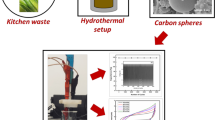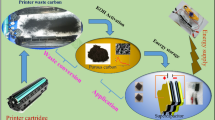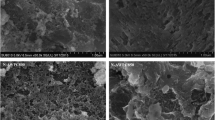Abstract
Herein, paint residue (PR), a kind of industrial waste, is firstly used as a raw material for the synthesis of the activated carbon (AC) for supercapacitors via a simple and traditional two-step strategy before rinsing. The hydrofluoric acid greatly affects the structure of the AC, thereby affecting the performance of the supercapacitor. As evaluated in a three-electrode 6.0 M KOH system, the material exhibits a high gravimetric capacitance of 254 F g−1 at a current density of 1.0 A g−1, and excellent cycling stability with 100% retention after 10000 cycles. A voltage window of 0–1.4 V due to its high oxygen and heteroatom contents in a symmetrical supercapacitor from PR, which demonstrates a comparatively higher energy density of 15.22 Wh kg−1 at a power density of 1081 W kg−1, with good rate capability of 70% retention at 10 A g−1. The favorable capacitive performances make this environmentally unfriendly residue PR act as a new resource of carbonaceous materials for high-performance supercapacitors.







Similar content being viewed by others
References
Y.G. Wang, Y.Y. Xia, Recent progress in supercapacitors: from materials design to system construction. Adv. Mater. 25(37), 5336–5342 (2013)
Y.Y. Lv, Y. Zhou, Z.Q. Shao, Y.H. Liu, J. Wei, Z.Q. Ye, Nanocellulose-derived carbon nanosphere fibers-based nanohybrid aerogel for high-performance all-solid-state flexible supercapacitors. J. Mater. Sci. 30(9), 8585–8594 (2019)
H.H. Liang, T. Sun, L. Xu, C.Y. Sun, D.W. Wang, A universal strategy towards porous carbons with ultrahigh specific surface area for high-performance symmetric supercapacitor applications. J. Mater. Sci. 30(14), 13636–13646 (2019)
P. Simon, Y. Gogotsi, Capacitive energy storage in nanostructured carbon-electrolyte systems. Acc. Chem. Res. 46(5), 1094–1103 (2013)
W. Qian, Z.Q. Chen, S. Cottingham, W.A. Merrill, N.A. Swartz, A.M. Goforth, T.L. Clare, J. Jiao, Surfactant-free hybridization of transition metal oxide nanoparticles with conductive graphene for high-performance supercapacitor. Green Chem. 14(2), 371–377 (2012)
B. Lu, Z. Xiao, H. Zhu, W. Xiao, W. Wu, D. Wang, Enhanced capacitive properties of commercial activated carbon by re-activation in molten carbonates. J. Power Sources 298, 74–82 (2015)
X. Hu, K. Nango, L. Bao, T.T. Li, M.D.M. Hasan, C.Z. Li, High yields of solid carbonaceous materials from biomass. Green Chem. 21(5), 1128–1140 (2019)
P. Simon, Y. Gogotsi, B. Dunn, Where do batteries end and supercapacitors begin? Science 343(6176), 1210–1211 (2014)
F. Beguin, V. Presser, A. Balducci, E. Frackowiak, Carbons and electrolytes for advanced supercapacitors. Adv. Mater. 26(14), 2219–2251 (2014)
Y.P. Zhai, Y.Q. Dou, D.Y. Zhao, P.F. Fulvio, R.T. Mayes, S. Dai, Carbon materials for chemical capacitive energy storage. Adv. Mater. 23(42), 4828–4850 (2011)
J.T. Zhang, J.W. Jiang, H.L. Li, X.S. Zhao, A high-performance asymmetric supercapacitor fabricated with graphene-based electrodes. Energy Environ. Sci. 4(10), 4009–4015 (2011)
Y.W. Zhu, S. Murali, M.D. Stoller, K.J. Ganesh, W.W. Cai, P.J. Ferreira, A. Pirkle, R.M. Wallace, K.A. Cychosz, M. Thommes, D. Su, E.A. Stach, R.S. Ruoff, Carbon-based supercapacitors produced by activation of graphene. Science 332(6037), 1537–1541 (2011)
D. Pech, M. Brunet, H. Durou, P.H. Huang, V. Mochalin, Y. Gogotsi, P.L. Taberna, P. Simon, Ultrahigh-power micrometre-sized supercapacitors based on onion-like carbon. Nat. Nanotechnol. 5(9), 651–654 (2010)
B. Yao, L.Y. Yuan, X. Xiao, J. Zhang, Y.Y. Qi, J. Zhou, J. Zhou, B. Hu, W. Chen, Paper-based solid-state supercapacitors with pencil-drawing graphite/polyaniline networks hybrid electrodes. Nano Energy 2(6), 1071–1078 (2013)
Z.Y. Yu, L.F. Chen, L.T. Song, Y.W. Zhu, H.X. Ji, S.H. Yu, Free-standing boron and oxygen co-doped carbon nanofiber films for large volumetric capacitance and high rate capability supercapacitors. Nano Energy 15, 235–243 (2015)
Y.J. Li, G.L. Wang, T. Wei, Z.J. Fan, P. Yan, Nitrogen and sulfur co-doped porous carbon nanosheets derived from willow catkin for supercapacitors. Nano Energy 19, 165–175 (2016)
Y.M. Wang, X.J. Lin, T. Liu, H. Chen, S. Chen, Z.J. Jiang, J. Liu, J.L. Huang, M.L. Liu, Wood-derived hierarchically porous electrodes for high-performance all-solid-state supercapacitors. Adv. Funct. Mater. 28(52), 1806207 (2018)
C. Wu, S.R. Yang, J.J. Cai, Q.B. Zhang, Y. Zhu, K.L. Zhang, Activated microporous carbon derived from almond shells for high energy density asymmetric supercapacitors. ACS Appl. Mater. Inter. 8(24), 15288–15296 (2016)
S.Y. Gao, K.R. Geng, H.Y. Liu, X.J. Wei, M. Zhang, P. Wang, J.J. Wang, Transforming organic-rich amaranthus waste into nitrogen-doped carbon with superior performance of the oxygen reduction reaction. Energ Environ. Sci. 8(1), 221–229 (2015)
M.Q. Wang, J. Zhou, S.J. Wu, H. Wang, W. Yang, Green synthesis of capacitive carbon derived from Platanus catkins with high energy density. J. Mater. Sci. 30(4), 4184–4195 (2019)
L.L. Qiang, Z.A. Hu, Z.M. Li, Y.Y. Yang, X.T. Wang, Y. Zhou, X.Y. Zhang, W.B. Wang, Q. Wang, Hierarchical porous biomass carbon derived from cypress coats for high energy supercapacitors. J. Mater. Sci. 30(8), 7324–7336 (2019)
C.T. Chen, S. Wang, Z.G. Peng, G.H. Ao, Hierarchical porous architecture on Ni foam created via an oxidization-reduction process and its application for supercapacitor. J. Mater. Sci. 30(12), 11231–11238 (2019)
P. Xing, B.Z. Ma, C.Y. Wang, L. Wang, Y.Q. Chen, A simple and effective process for recycling zinc-rich paint residue. Waste Manage. 76, 234–241 (2018)
J.K. Min, S. Zhang, J.X. Li, R. Klingeler, X. Wen, X.C. Chen, X. Zhao, T. Tang, E. Mijowska, From polystyrene waste to porous carbon flake and potential application in supercapacitor. Waste Manage. 85, 333–340 (2019)
C.M. Ashraf, K.M. Anilkumar, B. Jinisha, M. Manoj, V.S. Pradeep, S. Jayalekshmi, Acid washed, steam activated, coconut shell derived carbon for high power supercapacitor applications. J. Electrochem. Soc. 165(5), A900–A909 (2018)
J.L. Rivera, T. Reyes-Carrillo, A framework for environmental and energy analysis of the automobile painting process. Proc. CIRP 15, 171–175 (2014)
A. Pedram, N. Bin Yusoff, O.E. Udoncy, A.B. Mahat, P. Pedram, A. Babalola, Integrated forward and reverse supply chain: a tire case study. Waste Manage. 60, 460–470 (2017)
Q.L. Ma, Y.F. Yu, M. Sindoro, A.G. Fane, R. Wang, H. Zhang, Carbon-based functional materials derived from waste for water remediation and energy storage. Adv. Mater. 29(13), 1605361 (2017)
C.F. Xue, L. Feng, Y.A. Hao, F.J. Yang, Q. Zhang, X.L. Ma, X.G. Hao, Acid-free synthesis of oxygen-enriched electroactive carbon with unique square pores from salted seaweed for robust supercapacitor with attractive energy density. Green Chem. 20(21), 4983–4994 (2018)
X.J. He, N. Zhao, J.S. Qiu, N. Xiao, M.X. Yu, C. Yu, X.Y. Zhang, M.D. Zheng, Synthesis of hierarchical porous carbons for supercapacitors from coal tar pitch with nano-Fe2O3 as template and activation agent coupled with KOH activation. J. Mater. Chem. A 1(33), 9440–9448 (2013)
I.I. Gurten Inal, S.M. Holmes, E. Yagmur, N. Ermumcu, A. Banford, Z. Aktas, The supercapacitor performance of hierarchical porous activated carbon electrodes synthesised from demineralised (waste) cumin plant by microwave pretreatment. J. Ind. Eng. Chem. 61, 124–132 (2018)
C. Wang, J. Wang, W.T. Wu, J. Qian, S.M. Song, Z.B. Yue, Feasibility of activated carbon derived from anaerobic digester residues for supercapacitors. J. Power Sources 412, 683–688 (2019)
J.S. Xia, N. Zhang, S.K. Chong, D. Li, Y. Chen, C.H. Sun, Three-dimensional porous graphene-like sheets synthesized from biocarbon via low-temperature graphitization for a supercapacitor. Green Chem. 20(3), 694–700 (2018)
L. Sun, Y. Fu, C.G. Tian, Y. Yang, L. Wang, J. Yin, J. Ma, R.H. Wang, H.G. Fu, Isolated boron and nitrogen sites on porous graphitic carbon synthesized from nitrogen-containing chitosan for supercapacitors. ChemSusChem 7(6), 1637–1646 (2014)
A.C. Ferrari, J.C. Meyer, V. Scardaci, C. Casiraghi, M. Lazzeri, F. Mauri, S. Piscanec, D. Jiang, K.S. Novoselov, S. Roth, A.K. Geim, Raman spectrum of graphene and graphene layers. Phys. Rev. Lett. 97(18), 187401 (2006)
A.C. Ferrari, D.M. Basko, Raman spectroscopy as a versatile tool for studying the properties of graphene. Nat. Nanotechnol. 8(4), 235–246 (2013)
Y.N. Gong, D.L. Li, C.Z. Luo, Q. Fu, C.X. Pan, Highly porous graphitic biomass carbon as advanced electrode materials for supercapacitors. Green Chem. 19(17), 4132–4140 (2017)
H. Ganegoda, D.S. Jensen, D. Olive, L.D. Cheng, C.U. Segre, M.R. Linford, J. Terry, Photoemission studies of fluorine functionalized porous graphitic carbon. J. Appl. Phys. 111(5), 053705 (2012)
T.E. Rufford, D. Hulicova-Jurcakova, Z.H. Zhu, G.Q. Lu, Nanoporous carbon electrode from waste coffee beans for high performance supercapacitors. Electrochem. Commun. 10(10), 1594–1597 (2008)
Y.J. Kim, Y. Abe, T. Yanaglura, K.C. Park, M. Shimizu, T. Iwazaki, S. Nakagawa, M. Endo, M.S. Dresselhaus, Easy preparation of nitrogen-enriched carbon materials from peptides of silk fibroins and their use to produce a high volumetric energy density in supercapacitors. Carbon 45(10), 2116–2125 (2007)
R. Pietrzak, XPS study and physico-chemical properties of nitrogen-enriched microporous activated carbon from high volatile bituminous coal. Fuel 88(10), 1871–1877 (2009)
L.F. Chen, Z.Y. Yu, J.J. Wang, Q.X. Li, Z.Q. Tan, Y.W. Zhu, S.H. Yu, Metal-like fluorine-doped beta-FeOOH nanorods grown on carbon cloth for scalable high-performance supercapacitors. Nano Energy 11, 119–128 (2015)
Y.S. Hu, A. Kleiman-Shwarsctein, G.D. Stucky, E.W. McFarland, Improved photoelectrochemical performance of Ti-doped alpha-Fe2O3 thin films by surface modification with fluoride. Chem. Commun. 19, 2652–2654 (2009)
Z. Li, Z.W. Xu, X.H. Tan, H.L. Wang, C.M.B. Holt, T. Stephenson, B.C. Olsen, D. Mitlin, Mesoporous nitrogen-rich carbons derived from protein for ultra-high capacity battery anodes and supercapacitors. Energy Environ. Sci. 6(3), 871–878 (2013)
Y.R. Nian, H.S. Teng, Nitric acid modification of activated carbon electrodes for improvement of electrochemical capacitance. J. Electrochem. Soc. 149(8), A1008–A1014 (2002)
D. Puthusseri, V. Aravindan, S. Madhavi, S. Ogale, 3D micro-porous conducting carbon beehive by single step polymer carbonization for high performance supercapacitors: the magic of in situ porogen formation. Energy Environ. Sci. 7(2), 728–735 (2014)
X.M. Fan, C. Yu, Z. Ling, J. Yang, J.S. Qiu, Hydrothermal synthesis of phosphate-functionalized carbon nanotube-containing carbon composites for supercapacitors with highly stable performance. ACS Appl. Mater. Inter. 5(6), 2104–2110 (2013)
Y.L. Shao, M.F. El-Kady, C.W. Lin, G.Z. Zhu, K.L. Marsh, J.Y. Hwang, Q.H. Zhang, Y.G. Li, H.Z. Wang, R.B. Kaner, 3D freeze-casting of cellular graphene films for ultrahigh-power-density supercapacitors. Adv. Mater. 28(31), 6719–6726 (2016)
H.T. Liu, P. He, Z.Y. Li, Y. Liu, J.H. Li, A novel nickel-based mixed rare-earth oxide/activated carbon supercapacitor using room temperature ionic liquid electrolyte. Electrochim. Acta 51(10), 1925–1931 (2006)
E. Frackowiak, F. Beguin, Carbon materials for the electrochemical storage of energy in capacitors. Carbon 39(6), 937–950 (2001)
L.J. Xie, G.H. Sun, F.Y. Su, X.Q. Guo, Q.Q. Kong, X.M. Li, X.H. Huang, L. Wan, W. Song, K.X. Li, C.X. Lv, C.M. Chen, Hierarchical porous carbon microtubes derived from willow catkins for supercapacitor applications. J. Mater. Chem. A 4(5), 1637–1646 (2016)
Y.T. Luan, L. Wang, S.E. Guo, B.J. Jiang, D.D. Zhao, H.J. Yan, C.G. Tian, H.G. Fu, A hierarchical porous carbon material from a loofah sponge network for high performance supercapacitors. RSC Adv. 5(53), 42430–42437 (2015)
J. Chmiola, G. Yushin, Y. Gogotsi, C. Portet, P. Simon, P.L. Taberna, Anomalous increase in carbon capacitance at pore sizes less than 1 nanometer. Science 313(5794), 1760–1763 (2006)
D.L. He, W. Zhao, P. Li, Z.W. Liu, H.Y. Wu, L. Liu, K. Han, L. Liu, Q. Wan, F.K. Butt, X.H. Qu, Bifunctional biomass-derived 3D nitrogen-doped porous carbon for oxygen reduction reaction and solid-state supercapacitor. Appl. Surf. Sci. 465, 303–312 (2019)
G.F. Ma, F.T. Ran, H. Peng, K.J. Sun, Z.G. Zhang, Q. Yanga, Z.Q. Lei, Nitrogen-doped porous carbon obtained via one-step carbonizing biowaste soybean curd residue for supercapacitor applications. RSC Adv. 5(101), 83129–83138 (2015)
X.M. Guo, B.X. Feng, L.G. Gai, J.H. Zhou, Reduced graphene oxide/polymer dots-based flexible symmetric supercapacitors delivering an output potential of 1.7 V with electrochemical charge injection. Electrochim. Acta 293, 399–407 (2019)
L. Fang, Y.P. Xie, Y.Y. Wang, Z.W. Zhang, P.F. Liu, N.A. Cheng, J.F. Liu, Y.C. Tu, H.B. Zhao, J.J. Zhang, Facile synthesis of hierarchical porous carbon nanorods for supercapacitors application. Appl. Surf. Sci. 464, 479–487 (2019)
I.I. Misnon, N.K.M. Zain, R. Jose, Conversion of oil palm kernel shell biomass to activated carbon for supercapacitor electrode application. Waste Biomass Valori. 10(6), 1731–1740 (2019)
Acknowledgement
We acknowledge financial support from the special funds for basic scientific research operations of central universities (No. 2019XKQYMS06).
Author information
Authors and Affiliations
Corresponding author
Ethics declarations
Conflict of interest
The authors declare that they have no conflict of interest.
Additional information
Publisher's Note
Springer Nature remains neutral with regard to jurisdictional claims in published maps and institutional affiliations.
Rights and permissions
About this article
Cite this article
Zhang, H., Ren, Y., Sui, Y. et al. Recycle of industrial waste: a new method of applying the paint residue to supercapacitors. J Mater Sci: Mater Electron 31, 274–285 (2020). https://doi.org/10.1007/s10854-019-02488-2
Received:
Accepted:
Published:
Issue Date:
DOI: https://doi.org/10.1007/s10854-019-02488-2




